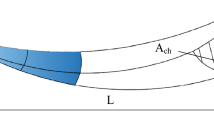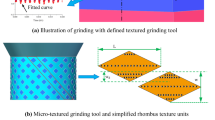Abstract
Structured grinding wheel has obvious advantages in reducing grinding force, and the structural parameters of grinding wheel have important influence on the reduction of grinding force. In order to determine the influence law of structural parameters on grinding force, the following theoretical modeling and experimental research work are carried out in this paper. Firstly, single grit scratching experiments of the workpiece material are carried out to determine the critical cutting depth for ploughing and cutting transition. The influences of structural parameters on the maximum undeformed chip thickness and the average contact arc length during grinding are analyzed in detail. The abrasive grains are simplified into a cone with an apex angle of 120°, the surface topography model of the structured grinding wheel is established according to the measured results of the distribution law of abrasive grains on the surface of the grinding wheel and the structural characteristic parameters. Combined with the grinding force model of single abrasive grain in ploughing and cutting stages, the grinding force calculation model of straight groove structured grinding wheel is established during the grinding process. Finally, grinding experiments are carried out to verify the accuracy of the theoretical grinding force model. The results show that the calculated values of grinding force are in good agreement with the experimental values, and the maximum calculation errors of tangential grinding force and normal grinding force are 14.5% and 11.8%, respectively. It is found that when the intermittent ratio of structured grinding wheel is constant, the groove width has little influence on grinding force. However, when the groove width is constant, the intermittent ratio has a great influence on the grinding force, and with the increase of the intermittent ratio, the grinding force decreases obviously.
















Similar content being viewed by others
Data availability
All data generated or analysed during this study are included in the present article.
References
Jamshidi H, Budak E (2020) An analytical grinding force model based on individual grit interaction. J Mater Process Technol 283:116700–116714. https://doi.org/10.1016/j.jmatprotec.2020.116700
Malkin S (1989) Grinding technology: theory and application of machining with abrasives. Ellis Harwood Publication, UK
Hecker RL, Ramoneda IM, Liang SY (2003) Analysis of wheel topography and grit force for grinding process modeling. J Manuf Process 5(1):13–23. https://doi.org/10.1016/S1526-6125(03)70036-X
Tang JY, Du J, Chen YP (2009) Modeling and experimental study of grinding forces in surface grinding. J Mater Process Technol 209(6):2847–2854. https://doi.org/10.1016/j.jmatprotec.2008.06.036
Jamshidi H, Gurtan M, Budak E (2019) Identification of active number of grits and its effects on mechanics and dynamics of abrasive processes. J Mater Process Technol 273:116239–116250. https://doi.org/10.1016/j.jmatprotec.2019.05.020
Durgumahanti USP, Singh V, Rao PV (2010) A new model for grinding force prediction and analysis. Int J Mach Tools Manuf 50(3):231–240. https://doi.org/10.1016/j.ijmachtools.2009.12.004
Hou ZB, Komanduri R (2003) On the mechanics of the grinding process – part I. Stochastic nature of the grinding process. Int J Mach Tools Manuf 43(15):1579–1593. https://doi.org/10.1016/S0890-6955(03)00186-X
Jiang JL, Ge PQ, Zhang Y, Wang DX (2012) A mathematical model of single grain forces in grinding process. Appl Mech Mater 229-231:1904–1907. https://doi.org/10.4028/www.scientific.net/AMM.229-231.1904
Jiang JL, Ge PQ, Sun SF, Wang DX, Wang YL, Yang Y (2016) From the microscopic interaction mechanism to the grinding temperature field: an integrated modelling on the grinding process. Int J Mach Tools Manuf 110:27–42. https://doi.org/10.1016/j.ijmachtools.2016.08.004
Li HN, Yu TB, Wang ZX, Zhu LD, Wang WS (2017) Detailed modeling of cutting forces in grinding process considering variable stages of grain-workpiece micro interactions. Int J Mech Sci 126:319–339. https://doi.org/10.1016/j.ijmecsci.2016.11.016
Zhang YB, Li CH, Ji HJ, Yang XH, Yang M, Jia DZ, Zhang XP, Li RZ, Wang J (2017) Analysis of grinding mechanics and improved predictive force model based on material-removal and plastic-stacking mechanisms. Int J Mach Tools Manuf 122:81–97. https://doi.org/10.1016/j.ijmachtools.2017.06.002
Walter C, Komischke T, Kuster F, Wegener K (2014) Laser-structured grinding tools–generation of prototype patterns and performance evaluation. J Mater Process Technol 214(4):951–961. https://doi.org/10.1016/j.jmatprotec.2013.11.015
Mohamed AMO, Bauer R, Warkentin A (2013) Application of shallow circumferential grooved wheels to creep-feed grinding. J Mater Process Technol 213(5):700–706. https://doi.org/10.1016/j.jmatprotec.2012.11.029
Dai CW, Yin Z, Ding WF, Zhu YJ (2019) Grinding force and energy modeling of textured monolayer CBN wheels considering undeformed chip thickness nonuniformity. Int J Mech Sci 157:221–230. https://doi.org/10.1016/j.ijmecsci.2019.04.046
Guo ZZ, Cheng J, Wu J, Zhang XF, Liu BY (2022) Modeling and experimental study on the grinding performance of precision diamond grinding tool with defined texture. Int J Adv Manuf Technol 1-22. https://doi.org/10.1007/s00170-021-08372-w
Li C, Piao Y, Meng B, Hu Y, Li L, Zhang F (2021) Phase transition and plastic deformation mechanisms induced by self-rotating grinding of GaN single crystals. Int J Mach Tools Manuf 172:103827. https://doi.org/10.1016/j.ijmachtools.2021.103827
Öpöz TT, Chen X (2015) Experimental study on single grit grinding of Inconel 718. Proc Inst Mech Eng Part B: J Eng Manuf 229(5):713–726. https://doi.org/10.1177/0954405414531114
Setti D, Kirsch B, Aurich JC (2019) Experimental investigations and kinematic simulation of single grit scratched surfaces considering pile-up behaviour: grinding perspective. Int J Adv Manuf Technol 103(1):471–485. https://doi.org/10.1007/s00170-019-03522-7
Liu YM, Gong YD, Cao ZX (2012) Analysis of numerical grinding wheel topology and experimental measurement. J Mech Eng 48(23):184–190. https://doi.org/10.3901/JME.2012.23.184
Ni J, Feng K, Al-Furjan MSH, Xu XJ, Xu J (2019) Establishment and verification of the cutting grinding force model for the disc wheel based on piezoelectric sensors. Sensors 19(3):725–738. https://doi.org/10.3390/s19030725
Li BK, Dai CW, Ding WF, Yang CY, Li CH, Kulik O, Shumyacher V (2021) Prediction on grinding force during grinding powder metallurgy nickel-based superalloy FGH96 with electroplated CBN abrasive wheel. Chin J Aeronaut 34(8):65–74. https://doi.org/10.1016/j.cja.2020.05.002
Li DG, Tang JY, Chen HF, Shao W (2019) Study on grinding force model in ultrasonic vibration-assisted grinding of alloy structural steel. Int J Adv Manuf Technol 101(5):1467–1479. https://doi.org/10.1007/s00170-018-2929-2
Gao Y, Wang FW, Liang Y, Han J, Su J, Tong Y, Liu L (2021) Cutting performance of randomly distributed active abrasive grains in gear honing process. Micromachines 12(9):1119–1135. https://doi.org/10.3390/mi12091119
Merchant ME (1945) Mechanics of the metal cutting process. I. Orthogonal cutting and a type 2 chip. J appl phys 16(5):267–275. https://doi.org/10.1063/1.1707586
Chen JY, Shen JY, Huang H, Xu X (2010) Grinding characteristics in high speed grinding of engineering ceramics with brazed diamond wheels. J Mater Process Technol 210(6–7):899–906. https://doi.org/10.1016/j.jmatprotec.2010.02.002
Xu XP, Li Y, Malkin S (2001) Forces and energy in circular sawing and grinding of granite. J Manuf Sci Eng 123(1):13–22. https://doi.org/10.1115/1.1344900
Funding
This project is supported by the National Natural Science Foundation of China (Grant No. 51905168), Natural Science Foundation of Hunan Province (Grant No. 2020JJ5192), and Hunan Provincial Key Laboratory of High Efficiency and Precision Machining of Difficult-to-Cut Material (Hunan University of Science and Technology) (Grant No. E21848).
Author information
Authors and Affiliations
Contributions
Yi Jun: conceptualization, methodology, supervision, and manuscript revision. Yi Tao: investigation, experimentation and data collection, data curation, and writing the original draft. Chen Bing: resources and funding acquisition. Deng Hui: original draft revision and review. Zhou Wei: writing review and editing.
Corresponding author
Ethics declarations
Ethics approval
Not applicable.
Consent to participate
Not applicable.
Consent for publication
Not applicable.
Conflict of interest
The authors declare no competing interests.
Additional information
Publisher's note
Springer Nature remains neutral with regard to jurisdictional claims in published maps and institutional affiliations.
Rights and permissions
Springer Nature or its licensor (e.g. a society or other partner) holds exclusive rights to this article under a publishing agreement with the author(s) or other rightsholder(s); author self-archiving of the accepted manuscript version of this article is solely governed by the terms of such publishing agreement and applicable law.
About this article
Cite this article
Yi, J., Yi, T., Deng, H. et al. Theoretical modeling and experimental study on grinding force of straight groove structured grinding wheel. Int J Adv Manuf Technol 124, 3407–3421 (2023). https://doi.org/10.1007/s00170-022-10747-6
Received:
Accepted:
Published:
Issue Date:
DOI: https://doi.org/10.1007/s00170-022-10747-6




